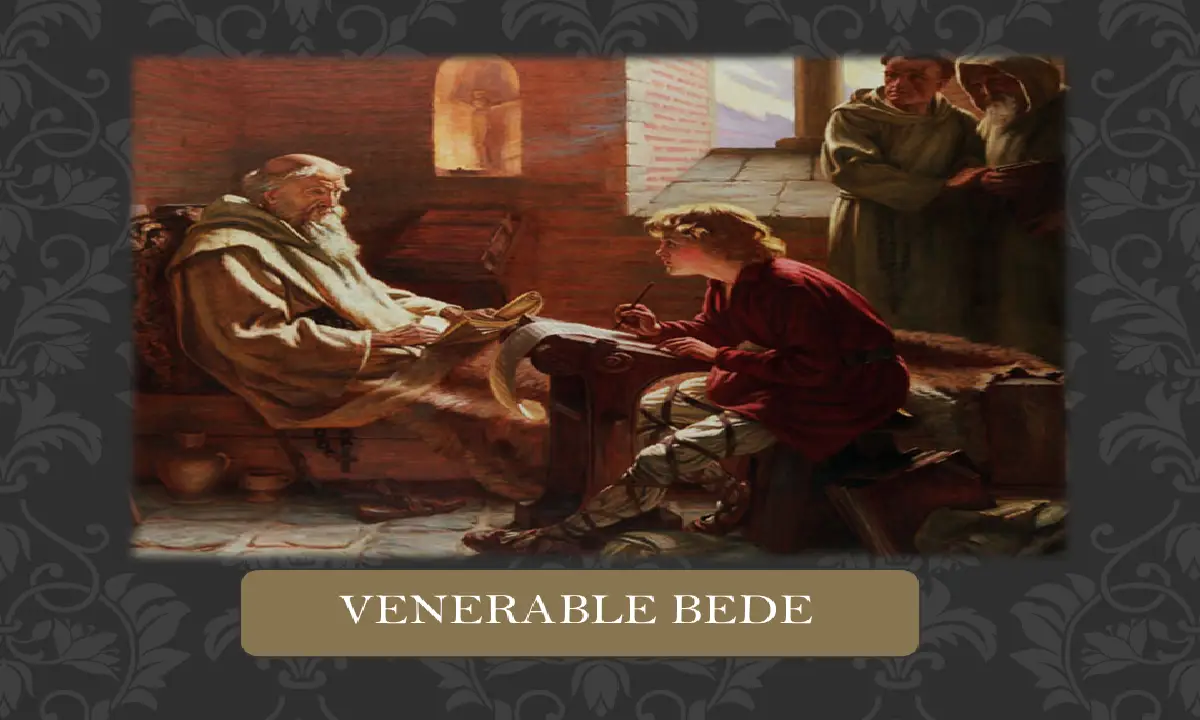
Early Life
- He was born around 672 AD in the kingdom of Northumbria (Monkton in Jarrow), in the far north of England.
- He studied at St.Peter at Monkwearmouth monastery as a boy.
- At the age of seven he entered monastery ‘of the blessed apostles of St.Peter and St.Paul’ in Wearmouth-Jarrow.
- In 685, he moved to Jarrow ,where he had access to a well-stocked library that had been created by abbot Biscop, the monastery of St.Paul.
- He almost certainly spoke Anglo-Saxon as his native language, but he learned to read, write and speak in Latin during his formative years at the monastery.
- Bede was ordained a deacon when 19 years old by his diocesan bishop, John, who was bishop of Hexham . He became a priest when 30.
- In about 701, he wrote his first works, the De Arte Metrica (Metrical Art or Art of Poetry) and De Schematibus Et Tropis (On Schemes [or Figures] and Troupes), a unified grammatical work.
Bede’s Works
- Bede’s works fall into three groups: grammatical and “scientific,” scriptural commentary, and historical and biographical.
- His early work De natura rerum (On the Nature of Things) is an encyclopaedic text. It gives contemporary theories on a wide range of subjects, including cosmology, time and arithmetic.
- His first treatise on chronology, De temporibus (“On Times”), with a brief chronicle attached, was written in 703.
- In 725 he completed a greatly amplified version, De temporum ratione (“On the Reckoning of Time”), with a much longer chronicle. It provides instruction in the use of different calendars, the meaning of the Zodiac and the calculation of Christian holy days such as Easter.
- He wrote many biblical commentaries, which focus on the reading and interpretation of Scripture. His earliest biblical commentary was probably that on the Revelation to John.
- He wrote two hagiographies of St. Cuthbert – one in verse and one in prose – as well as lives of the Continental saints Felix and Anastasius.
- His historical ‘martyrology’ ,a list of martyrs and saints arranged in calendar order, according to their feast days were equally important.
- Bede also wrote a variety of works on orthography (spelling conventions), and metre (poetic rhythm).
Father of English History
Bede is most famous for his Historia ecclesiastica gentis Anglorum (Ecclesiastical History of the English People) one of the best-written sources for early English history.
Ecclesiastical History of the English People
- Ecclesiastical History of the English People was completed in 731 when he was around 59 years old. This work was modelled on the Ecclesiastical History by the Greek historian Eusebius of Caesarea.
- Bede was aided in writing this book by Albinus, abbot of St Augustine’s Abbey, Canterbury.
- It is divided into five books and has around 400 pages.
- The first of the five books begins with a brief account of Christianity in Roman Britain, including the martyrdom of St Alban, is followed by the story of Augustine’s mission to England in 597, which brought Christianity to the Anglo-Saxons.
- The second book begins with the death of Gregory the Great in 604 and follows the further progress of Christianity in Kent and the first attempts to evangelise Northumbria.
- The third book recounts the growth of Christianity in Northumbria under kings Oswald of Northumbria and Oswy. The climax of the third book is the account of the Council of Whitby, traditionally seen as a major turning point in English history.
- The fourth book begins with the consecration of Theodore as Archbishop of Canterbury and recounts Wilfrid’s efforts to bring Christianity to the Kingdom of Sussex.
- The fifth book brings the story up to Bede’s day and includes an account of missionary work in Frisia and of the conflict with the British church over the correct dating of Easter.
- Originally written in Latin, King Alfred later translated it into Old English.
- Bede wrote a preface for the work, in which he dedicates it to Ceolwulf, king of Northumbria.
- Almost everything that is known of Bede’s life is contained in the last chapter of Historia Ecclestia.
ANNO DOMINI
The method of dating events from the time of the incarnation, or Christ’s birth—i.e., AD (anno Domini, “in the year of our Lord”)—came into general use through the popularity of the Historia ecclesiastica and the two works on chronology.
The Anno Domini method was invented by Dionysius Exiguus. Although Bede did not invent this method, his adoption of it and his promulgation of it in De Temporum Ratione (On the Reckoning of Time), his work on chronology, is the main reason it is now so widely used Bede’s Easter table, contained in De Temporum Ratione, was developed from Dionysius Exiguus’ Easter table
Bede’s death song
Bede’s Death Song is the editorial name given to a five-line Old English poem, supposedly the final words of the Venerable Bede.
It is the most-copied Old English poem, with 45 extant versions. The poem is also known as “Bede’s Lament”.
a modern English translation/interpretation by Michael R. Burch
Facing Death, that inescapable journey,
who can be wiser than he
who reflects, while breath yet remains,
on whether his life brought others happiness, or pains,
since his soul may yet win delight’s or night’s way
after his death-day.
Death of Bede
Bede died on 26th May 735 AD in Jarrow,Northumbria and was also burried there. Later it was transferred to Durham Cathedral. He was declared Venerable by the church in 836 and was canonized in 1899. Bede was named “Doctor of the Church” by Pope Leo XIII because of his work and piety. He is the only native of Great Britain to achieve this designation. St Bede is the patron saint of scholars and historians.